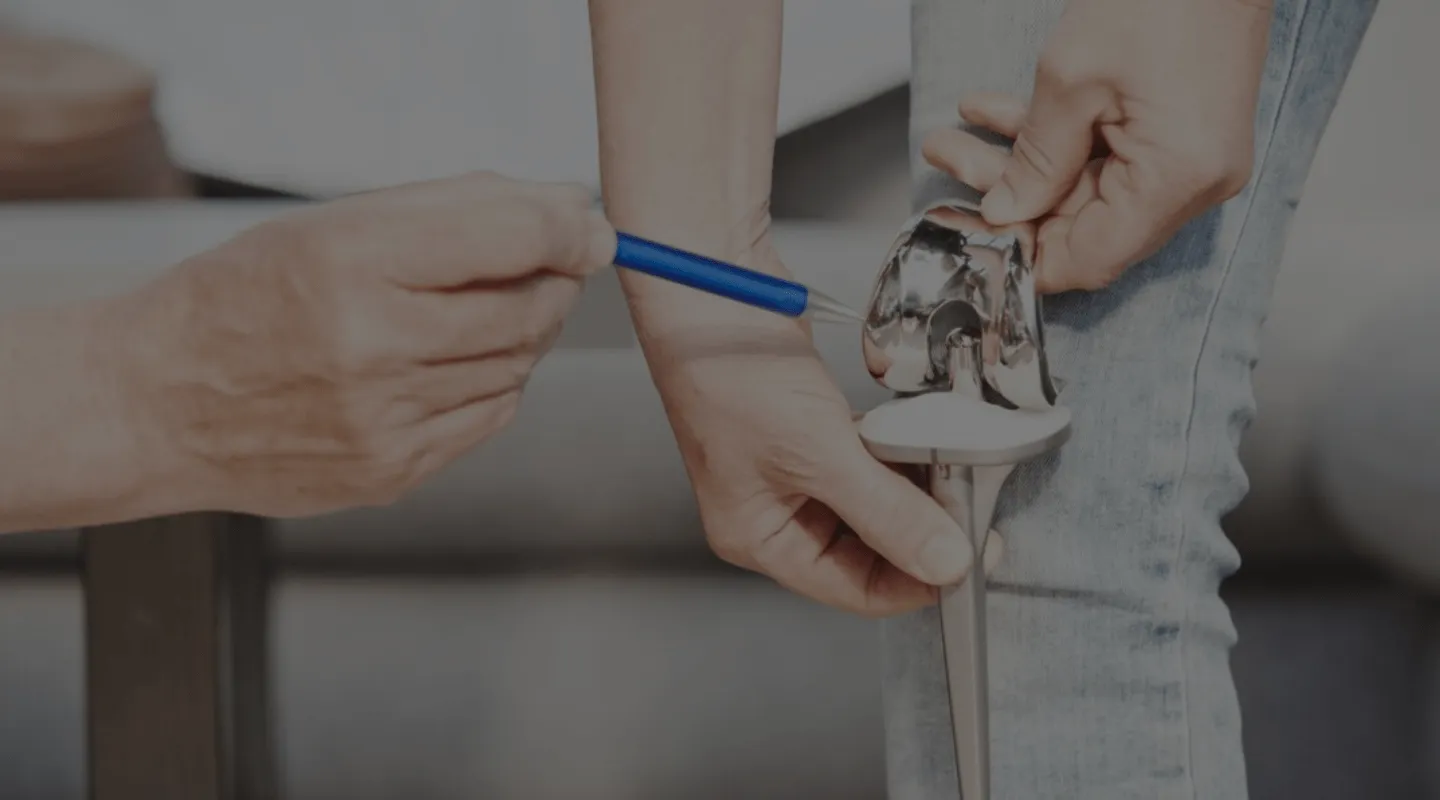
Knee Replacement
Your affordable knee replacement surgery in Tunisia
Regain your mobility and say goodbye to pain. Precise surgery performed by orthopedic specialists with a rapid recovery protocol.
How does it work?
What is Knee Replacement?
If you suffer from knee osteoarthritis, one solution available to you is knee replacement surgery in Tunisia. This orthopedic surgery procedure addresses the problem by replacing the affected knee with an artificial joint. This intervention allows you to regain better mobility and comfort in your daily life. Knee replacement and hip replacement are the two most common orthopedic interventions for foreign patients traveling to Tunisia. Discover our procedures for your knee surgery in Tunisia. Trust Tunisia Destination Santé for the organization of your medical stay.
Who is Knee Replacement Surgery For?
Knee replacement surgery is primarily for individuals experiencing severe pain and functional limitations due to joint conditions such as osteoarthritis, rheumatoid arthritis, or other forms of knee cartilage degeneration. This intervention is often recommended when conservative treatments like medication, physiotherapy, and corticosteroid or hyaluronic acid injections fail to relieve symptoms. It’s particularly beneficial for patients whose quality of life is significantly impacted by pain and joint stiffness, making daily activities like walking, climbing stairs, or even getting up from a chair difficult. Knee replacement surgery may also be considered for those who have suffered severe injuries or deformities of the knee. The goal of the procedure is to restore joint function, reduce pain, and improve overall mobility, allowing patients to resume a more active and comfortable life.
Knee Replacement in Tunisia: What is Knee Replacement Surgery in Tunisia?
Total knee replacement is a very common phenomenon. It affects a large number of people worldwide. It involves the progressive wear and tear of the knee cartilage. This wear can cause pain and significant discomfort during walking and physical activities. As a result, the affected patient experiences varying degrees of difficulty moving around. The individual is forced to significantly limit their physical and sporting activities, leading to other health problems later on. The factors that can cause this phenomenon vary from patient to patient: advanced age, overweight or lack of regular physical exercise…
While the use of analgesics can alleviate pain, no cure has yet been found to stop the degeneration of the knee. Implantation then becomes one of the best ways to permanently solve the problem. Depending on the condition of the knee, two options can be considered: implantation of a complete or partial prosthesis. This intervention is recommended for individuals aged 50 to 60 and over. However, it can also be performed on younger patients if certain conditions are met. Once the operation is performed, it is definitive and the results are permanent. The ceramic implants used for this procedure can have a lifespan of up to twenty years.
What is the cost of knee replacement surgery in Tunisia?
Choosing to have your total knee replacement surgery in Tunisia offers many advantages. Not only can you benefit from advantageous prices compared to those practiced in Europe, but you can also benefit from the expertise of our internationally renowned surgeons and modern medical facilities. Tunisia Destination Santé offers extremely competitive rates for your surgical stay in Tunisia. Our packages include all costs associated with your medical stay and your operation. Prices for a knee replacement start at €4500. This includes all medical expenses for partial or total knee replacement surgery in Tunisia. In addition, a 3-night hospital stay is also included.
Total Knee Replacement in Tunisia: What to Know Before You Start
Knee implant surgery requires extensive preparation. To ensure the success of your intervention, it is essential that you follow certain steps, including a comprehensive health assessment including radiological examinations and blood tests. Your medical file must also include your medical history. It is crucial that you have no medical conditions or pathologies that could hinder the operation. During your consultation with the surgeon, you will be fully informed about all aspects of the operation in question. They will inform you of the conditions for undergoing it, and the risks involved. We invite you to contact the Tunisia Destination Santé team for detailed information on compiling your medical file.
What are the different types of knee replacement?
If you suffer from recurrent joint pain or severe arthritis, know that there are different types of knee replacements currently available on the market. These prostheses differ in their fixation system, mobility, and design.
-
- Fixed knee prosthesis: This type of prosthesis uses cementation to fix the parts of the prosthesis to the bone. There are different options for implanting a prosthesis: it can be totally cemented, partially cemented, or uncemented.
- Mobile knee prosthesis: Mobile knee prostheses have been designed to allow a certain degree of freedom between the different parts of the prosthesis. This ability to move can help reduce prosthesis wear and thus prolong its lifespan.
- Unicompartmental knee prosthesis: This prosthesis serves to replace a specific section of the knee, mainly the inner or outer side. It is necessary when arthritis affects only part of the knee.
- Total knee prosthesis: The total knee prosthesis replaces the entire knee joint when it is affected by arthritis on both sides.
- Custom-made knee prosthesis: Patient-specific knee prostheses are designed taking into account the specificities of the bone structure. This method optimizes the fit and comfort of the prosthesis.
- Computer-assisted implantation (CAI) knee prosthesis: It uses computer assistance to plan and carry out surgical operations. Thanks to this method, it is possible to improve the precision of prosthesis implantations and reduce the risk of complications after the intervention.
- Fixed knee prosthesis: This type of prosthesis uses cementation to fix the parts of the prosthesis to the bone. There are different options for implanting a prosthesis: it can be totally cemented, partially cemented, or uncemented.
- Mobile knee prosthesis: Mobile knee prostheses have been designed to allow a certain degree of freedom between the different parts of the prosthesis. This ability to move can help reduce prosthesis wear and thus prolong its lifespan.
- Unicompartmental knee prosthesis: This prosthesis serves to replace a specific section of the knee, mainly the inner or outer side. It is necessary when arthritis affects only part of the knee.
- Total knee prosthesis: The total knee prosthesis replaces the entire knee joint when it is affected by arthritis on both sides.
- Custom-made knee prosthesis: Patient-specific knee prostheses are designed taking into account the specificities of the bone structure. This method optimizes the fit and comfort of the prosthesis.
- Computer-assisted implantation (CAI) knee prosthesis: It uses computer assistance to plan and carry out surgical operations. Thanks to this method, it is possible to improve the precision of prosthesis implantations and reduce the risk of complications after the intervention.
Partial Knee Replacement
Partial knee replacement, also known as unicondylar knee replacement, is an operation to replace a specific part of the knee joint. It is often recommended for people with localized osteoarthritis in a specific area of the knee, such as the inner or outer compartment. Partial knee replacement surgery involves using a smaller, less invasive prosthesis, which can reduce post-operative pain and improve recovery. However, it is important to note that this option is not suitable for all patients and may not be recommended for those with significant ligament or bone damage in their knee. After the operation, it is crucial to follow a rehabilitation and physiotherapy program to strengthen the muscles and restore joint mobility. Rehabilitation following partial knee replacement can take place in a specialized center, providing patients with personalized guidance and support tailored to their needs. Analgesics can also be administered to relieve pain after the operation. It is essential for patients to work closely with their surgeon to determine whether partial knee replacement is the best option for their individual case and to fully understand the risks and benefits associated with this surgical procedure.
Next-Generation Knee Replacement
Next-generation knee replacements are a significant technological advancement in the field of orthopedic surgery. They are designed to better mimic the natural structure of the knee joint, resulting in increased functionality and a longer lifespan. These prostheses are made with durable and resistant materials such as titanium and high-density polyethylene, as well as specially designed articular surfaces to limit wear and tear and minimize the risk of long-term complications. To meet the individual needs of each patient, next-generation knee replacements can now be customized using 3D modeling and 3D printing. This technological advance allows for the design of more precise prostheses that are better adapted to each person’s unique anatomy. In addition to being easier to install and requiring smaller incisions, these prostheses improve post-operative recovery by reducing pain. Thus, advances in the design and manufacture of knee replacements offer more effective and safer treatment options for patients with osteoarthritis or other conditions requiring surgical intervention.
Knee Replacement Recovery Time?
The recovery time after knee replacement surgery varies from person to person, but generally, it takes several weeks to several months for a complete recovery. The first few weeks are crucial for initial healing and pain management. During this period, the patient must follow an intensive rehabilitation program to strengthen the muscles around the knee and improve the flexibility and mobility of the joint. Most patients can walk with the help of a walker or crutches the day after surgery, and most can move around without assistance after about six weeks. However, it can take up to three months or more to regain near-normal knee function. Active participation in physiotherapy and adherence to medical recommendations are essential to accelerate the recovery process and ensure the success of the implant. During this period, it is important to avoid strenuous activities or sudden movements that could compromise healing. A complete recovery, including the complete disappearance of swelling and complete internal healing, can take up to a year.
What are the side effects of knee replacement?
Knee replacement surgery, while generally considered safe and effective, can lead to some side effects and complications. Some of the most common side effects include persistent knee pain, swelling, and stiffness, which can occur during the recovery phase. Some people may also develop infections at the surgical site, often requiring antibiotic treatment. Another risk is the formation of blood clots in the legs, known as deep vein thrombosis, which can occur due to post-operative immobility. Additionally, although rare, there is a risk of prosthesis failure or displacement of the implant, requiring additional surgery. Patients may also experience allergic reactions to the materials used in the prosthesis, such as metal. It is essential to discuss these risks with the surgeon before the procedure to fully understand the preventive measures and follow post-operative advice to minimize these complications.
How does knee replacement surgery work?
The operation is performed under general anesthesia. It lasts on average between 60 and 120 minutes, depending on the patient’s case. Hospitalization lasts an average of 5 days. The surgeon makes an incision of about a few centimeters, usually located above the knee, to access the area to be treated. This incision will allow them to manipulate their surgical instruments and remove the damaged cartilage. Once this step is complete, they proceed to the placement of the prosthesis, then close the incision using absorbable sutures. The three-part prosthesis, comprising a femoral part, a tibial part, and a medial part, will then be precisely inserted by the surgeon.
Post-operative care for knee replacement in Tunisia
A few days after the operation, you will be able to get up and walk with the assistance of our nurses following your operation. Our professionals will also prescribe you medical treatment to relieve pain and facilitate your convalescence. Physiotherapy sessions will also be recommended. Once you leave the clinic, you will need to follow an adapted rehabilitation program. This program lasts for a few weeks and must be carried out in a specialized center.
Our advantages


What kind of pain after knee replacement?
After total knee replacement surgery, it’s normal to experience pain as part of the healing process. This pain can last from a few days to several months, depending on individual tolerance and the complexity of the procedure. It can be localized around the scar and inside the knee, and may also be accompanied by stiffness, swelling and difficulty moving the leg. To relieve this pain, patients can take analgesic medication. For optimal recovery after surgery, it is essential to comply with the surgeon’s recommendations and report any persistent pain or unusual symptoms to their doctor. Over time, post-operative pain usually subsides, allowing patients to resume their daily activities with a functional, pain-free knee. Do not hesitate to communicate any concerns to your doctor for a successful recovery.
Success rate of knee replacement
Knee replacement surgery boasts an impressive success rate of around 95%, making it one of the most effective surgical interventions for treating pain and functional limitations associated with osteoarthritis and other knee pathologies. This high success rate means that the majority of patients see a significant improvement in their quality of life, with reduced pain and increased mobility. Most patients are able to resume their daily activities, walk without pain and even participate in moderate physical activities after rehabilitation. Factors contributing to this success include appropriate patient selection, advanced surgical techniques, and well-designed rehabilitation programs. However, it is important to note that the long-term success of knee replacement also depends on the patient’s overall health, adherence to medical advice and management of risk factors, such as weight and physical activity, to maintain the functionality of the implant over time.
Contact and request a quote for a knee replacement
Want to discover medical tourism in Tunisia? Entrust the organization of your stay to Tunisia Destination Santé, a reliable and experienced agency. Our team is entirely dedicated to assisting you throughout the process. We accompany you from A to Z in compiling your file and planning your trip. Do not hesitate to contact us for more information and to request a free, no-obligation quote.
Your health, our priority.
Request your free quote.
Frequently Asked Questions
Some people report increased sensitivity to weather changes, particularly changes in barometric pressure, even with a knee replacement. However, this varies from person to person and is not systematic.
Yes, metal allergies can be a problem. It is essential to test for allergies before the operation, and non-metal or ceramic prostheses can be considered in case of proven allergy.
High-impact sports are generally not recommended after a knee replacement. However, some low-impact sports such as swimming or cycling are often recommended and can be practiced without major risk.
Yes, knee replacements contain metallic materials that can trigger metal detectors. It is advisable to carry a card or medical note to facilitate security checks.
Yes, revision of a knee replacement is possible if the first prosthesis wears out or develops complications. The procedure is more complex, but it is feasible with adequate planning.
Yes, the lifespan of a prosthesis can vary. Younger and more active patients may wear out their prosthesis more quickly than older and less active patients, potentially requiring revision sooner.
Rejection of a knee replacement is rare because the materials used are biocompatible. However, inflammatory reactions or infections can occur and require medical intervention.
Some studies suggest that acupuncture can help reduce post-operative pain and improve functional recovery after knee replacement surgery. However, results may vary depending on the individual.
Most patients regain normal walking and good balance after rehabilitation. However, this depends on the quality of rehabilitation and the patient’s physical condition before and after the operation.
Yes, there are ongoing advances in prosthesis materials, such as the use of advanced ceramics and polymers to improve durability and reduce wear. New technologies, such as custom 3D-printed prostheses, are also under development.
